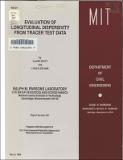Evaluation of Longitudinal Dispersivity from Tracer Test Data
Author(s)
Welty, Claire; Gelhar, Lynn W.
Download20309754.pdf (4.204Mb)
Metadata
Show full item recordAbstract
Introduction: Mathematical modeling of solute transport has become a standard tool for evaluating the movement and spreading of chemical contaminants in the subsurface aquatic environment. Most frequently, numerical techniques such as finite element or finite difference methods are used to solve the governing partial differential equations of flow and solute transport over a large aquifer region, in order to predict the concentration of a chemical contaminant at some future time and at points distant in space from a source. One problem that continues to plague users of these techniques is estimation of mixing or dilution parameters, or more specifically the dispersivity (if the dispersion coefficient is assumed to be the product of dispersivity and mean pore velocity), in the governing equations. Summaries of field observations (e.g., Lallemand-Barres and Peaudecerf, 1978; Anderson, 1979; and Gelhar, et al., 1985) and theoretical studies (e.g., Gelhar and Axness, 1983) both have indicated that dispersivity is a function of the heterogeneity of the geologic formation and that there is a dependence of the value of dispersivity on the solute displacement distance in the aquifer. Typically, then, there is a need to determine a value for dispersivity for the aquifer material and scale of problem at hand. Tracer tests are often attempted as a means of estimating the required dispersivity. Figure 1-1 from Gelhar, et al. (1985), summarizes the information available on longitudinal dispersivity values determined from tracer tests conducted at various length scales and on many type of aquifer materials around the world. Figure 1-2 illustrates the ranking of the relative reliability for these same data, based on judgements about the type of experiment and method of data interpretation. This graphical summary reinforces the fact that modelers indeed face difficulties in determining the proper value of dispersivity for a given problem. It is with this motivation in mind that we explore improved methods for analysis of tracer tests to yield accurate information on dispersivity values. This will contribute to more realistic modeling of the solute transport process in evaluation of groundwater contamination cases. The two overall goals of this study are: 1) to develop and demonstrate improved methods of analyzing existing tracer test data; and 2) to use this information and experience to better define the reliability of existing data and to provide an improved basis for selecting, designing, and analyzing tracer tests.
Description
Scanning notes: Missing innner title page. Page 32 contains text that runs off edge of page. Disclaimer scanned. Prepared with the support of U.S. Environmental Protection Agency and National Science Foundation.
Date issued
1989-03Publisher
Cambridge, Mass. : Ralph M. Parsons Laboratory Hydrology and Water Resource Systems, Dept. of Civil Engineering, Massachusetts Institute of Technology
Other identifiers
320
Series/Report no.
R (Massachusetts Institute of Technology. Department of Civil Engineering) ; 89-5.Report (Ralph M. Parsons Laboratory for Water Resources and Hydrodynamics) ; 320.